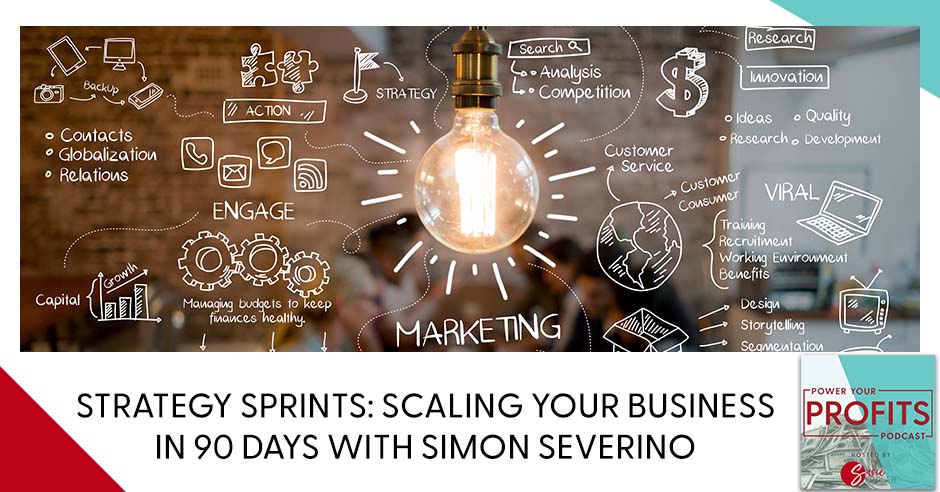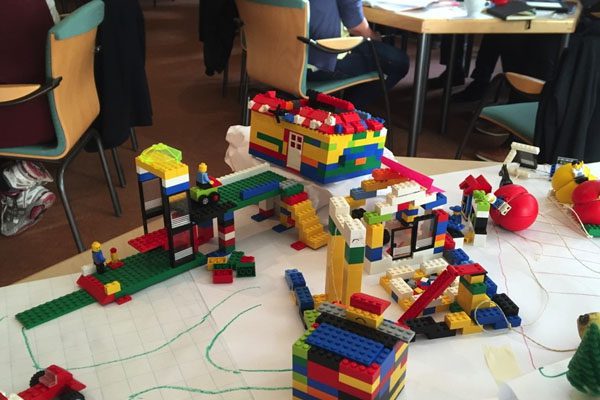
If you want to scale your business quickly, you need to identify your bottleneck ASAP. You need to create daily, weekly, and monthly habits just for that one bottleneck until it is solved. Start working on your highest income-producing activities to scale. Be an agile company by setting up modules that you can plug and play into your projects. This is how you scale the number of clients you have. Join Susie Carder as she talks to the founder of Strategy Sprints, Simon Severino about scaling your business with a game plan. Discover how the Strategy Sprints program works and how you can take control of your business. Also, learn more about Simon’s wealth strategy and why you should know how to grow money from money.
—
I am so excited that you’re here. You’re going to love our guest. Simon Severino helps business owners in SaaS services, which is a software company that helps run their company more effectively in sales that soar. Trusted by Google, Roche, Consilience Ventures, Amgen and AbbVie, he has created the Strategy Sprints, a method that doubles revenue in 90 days by getting owners out of the weeds and focusing on the highest income-producing activity. What I love is there are tools for it. He gives meat and potatoes. He is a TEDx speaker, contributor to Forbes and Entrepreneur Magazine and member of the SVBS, Silicon Valley Blockchain Society. Please welcome my guest, Simon. It is such a delight to have him.
—
Simon, I’m so excited. You’re my brother from another mother. We speak the same language. I geek out with the tools and strategies that you do because I’m like, “Where were you when I was a young entrepreneur not knowing my hiney from a hole in the ground?” Welcome.
Susie, let’s do this.
Tell everybody what your sweet spot is. Who do you serve, so we’re clear on your magic or your genius? I only have geniuses on my show.
I fell in love with the go-to-market topic many years ago and every day, I’ve been showing up to help people with go-to-market. Right now, at Strategy Sprints, which is my company, product and program, in 90 days, we double revenue for B2B businesses. They need to be at around $35,000. They have something that the world wants and takes and we can double it from there because one part is systemizing and one part is scaling and that’s our superpower. That’s what we do.
Strategy Sprints coaches to only scale and we love it because it’s intellectually stimulating. Do we take this angle or that angle? What about that competitor? It’s also emotionally stimulating because it’s all about the right timing. If we are too early, “That’s too early.” If we are too late, “That’s too late.” What’s the right moment? It’s both intellectually and emotionally stimulating. That’s why I do it. The team at Strategy Sprints is having fun helping people scale faster than they would without blueprints and proven processes.
We call that strategy stress because so many people in the industry tell us what to do and we’re like, “Who do I listen to?” I find people go, “Listen to Simon. Listen to Susie.” They’re trying the Band-Aid, bubblegum, shoestring and duct tape strategies. It’s like, “No. Pick your coach.” Pick the person. Be consistent. It takes a minute, especially at that level. If you’re at $350,000 and you want to scale it to $1 million, $2 million or $5 million, you can’t be jumping around. You’re not jumping around in relationships when you’re ready to be in a relationship. Before that, you can jump around all you want.
I don’t listen to anybody and I would not recommend listening to anybody except your users or markets. Who do I listen to? I have coaches from year to year and I learn, but who do I listen to? My market data. Every seven days, we will explore the daily habit, the weekly habit or the monthly habit. The weekly habit is, “What’s the marketing number of this week? What’s the sales number for this week? What’s the ops number for this week? That’s the Sprint dashboard because the Sprint is 12 weeks, 12 sprints.
[bctt tweet=”If you want to scale faster, don’t listen to anybody except your users and markets.” via=”no”]
Every Friday, we look at this dashboard and this dashboard is telling me my reality. That’s the only thing that I listen to. I take inspiration and I have coaches. I have courses, books and all this wonderful stuff. I say, yes, let’s try it and I give it a try, but what will be the answer if it’s working or not? The Sprint dashboard will tell me on Friday because that’s telling me, this works, this doesn’t.
You opened up a can of worms because everybody wants the Sprint dashboard. How do they get the Sprint dashboard because everybody wants that now?
It’s one of the free gifts that we will give at the end. They go to StrategySprints.com/tools and they can download them. They’re open source. It’s pretty simple. The core of the Strategy Sprints Method is a daily, weekly and monthly habit because 95% is not in your control. The supply chain is not in your control. Markets are not in your control. Prices are not in your control. What the heck is in your control? The three habits. I call them the three CEO habits.

Daily, write down how you allocate your time. Decide what you will delegate or automate tomorrow. Weekly habit, show me in real-time the marketing number, the sales number and the ops number for this week. You pick the most important one. The one that will tell you if you are moving in the right direction or at the right pace. We help you as Sprint coaches, but then you define it and we will measure that every seven days. The dashboard will show you what’s working for all your activities. Which one is working and which ones are not?
At the latest, every seven days, you stop doing some things that are not working and you do more of what’s working for you. That’s why I say I don’t listen to anybody. I take all the wisdom of everybody and if it clicks, I’m going to try it up until Friday. On Friday, the dashboard tells me if, for me right now, this is working or not because of all these beautiful tools you have to see if they work for you right now.
Simon is speaking my love language right now because he’s giving us spreadsheets and we love spreadsheets. I love it because data doesn’t lie. It tells us the story of what’s happening. As a young entrepreneur, it had me get out of my emotions of, “We had a good week. We had a bad week,” because that’s business. When you’re young in the business and sometimes even in your season, you let that bad week or the cycle of business crush you and go, “I suck.” “No. Let’s put the stick down. Don’t say you suck. Let’s be in the juice of it.
We don’t ever start with a giveaway, but you dropped the bomb and tossed it, “I got this thing for you. This thing that works for my clients,” which is incredibly generous. Thank you for that. We appreciate that and love that. We’re going to go over gold. Let’s talk about how we identify the bottleneck. Because right now and the beauty of COVID, the pandemic and there’s always something like a recession, depression, pandemic, or some kind of something in the history of business.
It is what it is. You’ve been through them. I’ve been through them, the financial collapse. How do I identify where the bottleneck is and what do I do? Because I think so many people are in this confusion and overwhelm and shut down and we want to get them out of that. We want to snap out of it. Do you remember Moonstruck’s Snap Out of It and she slaps him in the face?
What most teams do is have too many things and activities running at once. When you run so many activities, the overall improvement is low. How do you increase the overall improvement? By first finding the current bottleneck. The bottleneck is the current weakest part of your system. Let’s say a business, if we simplify, is made of marketing, sales, operations, positioning and mindset. These five things and you have a business.
Should you improve Instagram? Should you improve your cold calling? Should you improve the website? There are a hundred possibilities. A Sprints coach will help you identify in eight minutes what the current bottleneck is. It’s the weakest part and one of the questions that they use is if you 10X next week, which partly breaks first? You go through them, the marketing, sales and operations. Maybe you can sell ten times more, but can you deliver?
In this case, operations would be your bottleneck or you can deliver, but you get so stressed. Mindset will be your bottleneck because you also have to be energetically ready to do that. If tomorrow Oprah Winfrey calls me and says, “Simon, hop on stage,” I’m not ready for it. You have to be ready for that. You have to train for a couple of years every day to be ready for that level.
What are you ready for? The bottleneck is always the weakest part and if you put some activities, some attention, and some energy per week into solving the bottleneck first and when that is solved, next week you move to the next bottleneck, you have a much higher impact and throughput than if you only improve everything a little bit.
You do a little bit of Instagram, LinkedIn and improve the onboarding system. Instead, one bottleneck after the other. That’s why we have a 90 days game plan. It’s twelve bottlenecks that we solve in a specific order. Sales bottleneck, operations bottleneck, marketing bottleneck, positioning bottleneck and mindset bottleneck. You have to find the current one and that order is very individual. It depends on your team right now, but in eight minutes, you can quickly identify it and then you focus on this week. Everybody in the team works on solving this.
It’s so clear and concise. What had you geeked out about putting these systems and structures together? What propelled you to focus on this? Because a lot of people teach theory, but you give tools. It’s meat and potatoes. Yes, we all need motivation, but at the end of the day, I need it to solve my challenge. What had you start this business the way that you’re doing it? What was your original passion?
Yesterday, I had a human design expert on my show and she did some life charting and she nailed it. She said, “Simon, you are a generator and your type.” I knew nothing about it. She said, “You are a scientific investigator. That’s what drives you. You want to break through things. You want to do things.” You only believe in things you do yourself with your hands and don’t listen to anybody. You do stuff and when it works, then it’s a proven system. When it’s a proven system, you share it. That’s the story of my life.
She says, “Yeah, I see it is from the chart.” That’s what I do. I don’t believe in any tactics or strategies because they might work, but I have to find out on my own. First, I explore the territory. Let’s see. If I send a daily email, maybe it’s even better than a weekly one. I didn’t know until I tried, so I tried. I found out daily’s better. I share it. I create a spreadsheet. I create a five minutes video. I show everybody the numbers and how they change, which becomes a module in Sprint University. That’s my passion.
I love to put together different staff to explore new territory and when I find something because I have the courage to do it. It’s my nature. I like to explore new territories. When I find something, I’m so proud. I come back and say, “Look what I found.” That’s the tool that I share with everybody because what’s the most joyful thing to do? When you have abundance, the most joyful thing is sharing it. It doubles my joy.
[bctt tweet=”When you have abundance, the most joyful thing to do is to share that.” via=”no”]
Let’s look at what habits I need as a CEO. What are the three habits that we need to be focusing on?
Daily, weekly and monthly. Daily, you write down how you spend your time and select which of those tasks will tomorrow be delegated, outsourced or automated. One of those is a time waster. You need to move to the next higher level. Pick one and tomorrow, you’ll delegate it to software or to a person or to an outside person, outsource. That’s the daily habit and not only the owner. Everybody in the team does that because everybody is a leader in their field. Everybody leads.
We’re doing that for each thing until we eliminate the minutia and the time wasters and only work on the highest income-producing activities.
That’s daily and this is how you scale. For example, my colleague Michelle who came in five years ago as a VA in the marketing department, now runs the marketing department. She hires people that I don’t even know who they are for a couple of weeks, at least until they show up in the meetings, because she does the same thing. She does the daily habit. She realizes that the data entry of the CRM she should be delegating that. She’s doing the same thing that I did. That’s a daily habit.
This is how you identify what to automate next, what to systemize next or what to write down as an SOP, Standard Operating Procedure. Everybody says, “You have to scale. You have to automate, but which one? This is how you identify it. By going through your tasks of this day and picking one. The one that was lowest leveraged, the one that you want to get rid of or the one that is easiest to hand over.
It is simple. I always tell my clients it doesn’t have to be hard. It has to be strategic. You’re giving the strategy and I love that it’s reflecting more. My old business partner, I used to come into his office and he’d be sitting there. I’m like, “What are you doing?” I’m like, “Chop-chop. Let’s get to work.” He goes, “I’m thinking about what’s the right process?” “That’s a waste of time.” My naivety as a young business person.
He goes, “No, Susie, you need to stop and reflect on what you’re doing and why you’re doing and quit being in the dig. I need you to get out of it because there is so much in it that you’re no different than Julie or Steve, which are your employees who are amazing. He goes, “Until you learn to slow down to speed up, you’ll never get where you want to be. You’ll always be in the grind and the dig. I’m like, “Okay.” The way you said it feels so much better than the way he said it, but I get it. It’s the same thing.
We call it the daily flow. People can download it from StrategySprints.com. It’s a daily flow. I write down what I did today and then in five minutes, it asks me two questions. One is, of all these things, which one will you delegate tomorrow? The second is if you would leave more freely and more intentionally, what will you do tomorrow?
That’s the difference between the agile company and the rigid company. I think I may have had both. I had a rigid company. It is the rule. It is the SOP. Let’s talk about both of them.
The rigid company cannot react quickly to stuff that happens and the agile company can. How do you build an agile company? If you have kids, you know the difference between DUPLO and LEGO. DUPLO is big parts and if you have a horse out of DUPLO, that’s just a horse. Nothing else. LEGO is very small parts. If you have a horse out of LEGO, you can recombine those into a house, into a fireman or into a dog. That’s agile. The same elements, but you can recombine them differently.

The difference is only the modularity. Every engineer knows modularity. You pick something. You break it down into its simplest components, but those components can be built together as the whole thing. They can also be recombined into different things. This is how you have an agile company. For example, Sprint University is 274 modules. A module is a video, a template and a prompt, homework for you or a process that you have to do in three hours. That’s one module.
If somebody says, “I want to double revenue in 90 days,” and I’m a software business, then the Sprints coach knows exactly, “I take module 78, module 16, module 41 and I put it together. Are you a B2B or B2C SaaS? For the client, customized is exactly what they need right now, but for your team, it should always be ready in modules because they don’t need to reinvent the wheel. If you’re a pro, if you focus on one thing and that’s maybe something we’re sharing that why should you focus on one thing for a while? When I say a while, I mean ten years and then you can modularize.
You just threw it. Speak the truth, Simon.
I’ve been doing one thing for 21 years and it’s not boring. As you can feel, it’s still exciting and you build those models. They are ready or semi-ready. For your team, it’s so much easier to recombine them. If you’re a knowledge worker, don’t think that you have to start every project and you will reinvent the wheel. There are some parts of the projects that you can modularize and keep ready and then you do a plug-and-play. This is how you scale the number of clients that you can take in per unit of time, per week or per month.

Talk about speed versus velocity because that works inside of agile and rigid.
You can build a ton of staff, which would be speed, but speed alone is not worth anything because you can run a marathon as the fastest person but in the wrong direction. Velocity is direction, including speed or speed in the right direction. That’s from physics. It says, what’s the direction? What’s the right direction? This ties back to the weekly habit.
We had the daily habit around the time, the weekly habits. One marketing number, one sales number, and one ops number for this week in one simple spreadsheet dashboard. It’s visual in front of you and it tells you two things. Are we going in the right direction at the right pace? That’s your velocity. You will only know when you measure it. You run your activities. You look at those three numbers. Are they going up? It’s working. It’s simple as that. What is the benchmark? The benchmark is your sale. The same team as last week and 1% will be great.
If you can get 1% better next week in these same metrics, amazing. You are very resilient. You are unstoppable, actually, because it compounds. We meet on Friday and I say, “What’s the difference? What are variations?” My colleagues say, “This one, it’s 0.8%. It’s a 0.8% improvement from last week. Let’s say the number of email subscribers is the marketing number. The number of subscribers or the sales number is a dollar amount. The ops number can be the number of client referrals. The client referred us to other clients.
Let’s say that number went up 0.8%. We are happy and we make some sounds. “Who did this? You did this. Congrats.” We’re happy. It’s a 0.8% increase, but we know that we are moving in the right direction at the right pace. It’s easy to repeat it because you know it’s working. You know you can do it. It’s okay. We repeat it and make it a little bit more intense.
Let’s shift strategies a little bit. I love meat and potatoes. Let’s talk about what has been your biggest failure in business and then what’d you learn? It could be your life too because sometimes that’s bigger than business. I call them failures, learning or challenges, whatever you want to call it and then what do you learn from them in all your years of being in business?
My biggest failure was investing in Luna. It tanked in four hours, which is tied to something I learned very late.
What was Luna?
Luna is this blockchain coin, a so-called stablecoin that was everything but stable. I bought a bunch of prep. This was the thing that I learned, whether at school or from my parents. How do you grow money from money? I knew only the other side. How do you generate money? I’m great at creating revenues and then I learned how to create revenue systems. I thought, “If you want to grow money, you have to bring in more projects, bigger projects.” I became very good at that, but after twenty years, I realized, first, there is a limit to that, the time per day limit.
Second, what do you do with it then, especially after inflation and the loss of purchasing power came in? I was like, “The real inflation is 15%. If I have it in my bank account, it’s losing 15% every year. I don’t like that. I have to learn how to grow money from money. I have to learn the investor skills.” I didn’t. I had some real estate, but I was bad in stocks. I learned stock investment and as a systems guy, I started creating my own investment systems.
How do I create a portfolio? What size to allocate and rebalance? My biggest mistake was not knowing what to do with money and I’m learning this. It’s now three years that I am on this journey and I’m getting better every week. I finally realized that if you are reading, start learning how to grow money from money early. Even if you only save a couple of hundred bucks per month, get them to work for you. Ideally, you save 50% of your profits and you get them to work every week or every month.
[bctt tweet=”Learn how to grow money from money early. Get your money to work for you.” via=”no”]
What has been your wealth strategy? I love that you’re fresh in it and you’re still young. I started at 25. Luckily, I was in a networking group and Suzanne Latour sat me down. I’m like, “I’m young. I’m making money and spending it.” She goes, “What are you doing? No. You don’t need another outfit. You’re done. Let’s take that money and invest it.”
I’m like, “Okay,” but what a great friend, to be honest, to go, “You don’t need another pair of shoes.” What’s been your wealth strategy that you now know? I invested in a company and it was back in the dot-com days. It was a lot of money back then and I got a letter one day, “We’re sorry. We couldn’t make it work.” “What do you mean you couldn’t make it work? That’s not an option.”
My wealth strategy is pretty simple. Every week, I take 50% of the profits and the profits mean it’s surplus money. I don’t need to spend it. I don’t need it for the next six months. I invest it and the investment buckets are 30% real estate, 30% stocks, equities and 30% digital assets, crypto assets. That’s my distribution. Part of it is cash, and I have a higher cash position in a bear market like now. Let’s say 15% or 20% and in a bull market, I try to have 0% cash. I want to be all in the market while it works.
Right now, I have a higher cash position because right now it’s shopping time. It’s a bear market heading into a recession. Now, it’s time to be in cash and to buy soon cheap. In those buckets, that 30%, my real estate is very passive things. In my region, the best thing is to have big complexes with very small apartments in there that are near infrastructure because that’s the easiest to handle and that’s what people always need. I have that thing and that’s very passive. It’s managed by other people and it’s passive.
Also, stocks. The only stocks that I understand and my favorite ones right now are Google, Tesla, Amazon and Apple. Whenever they dip slightly by 2%, 5%, or 10%, I buy more. They dip 15%, I go all in, and also Berkshire Hathaway because those are long-term value creation and they are strong in cashflow. They are the winners. Nothing will happen to them. Whatever happens, they’re going to grow. These are the stocks.
In crypto, I go Bitcoin, Ethereum and Solana right now. Just the three, for my perception, strongest horses and I have a DCA plan. It means that every Friday, a specific amount, a set amount, gets both automatically. The biggest one is Bitcoin and then two small amounts in Ethereum and Solana because I don’t want to think about it. I want the emotions out. That’s my investing system. Once a week, I look at the overall allocation and the sizes, if it’s right or if I need to rebalance. I study what’s going on in the world technologically and the macropolitics. I know if I have to change my thesis that maybe Google is not a winner anymore or Tesla’s not a winner anymore, then I would sell them.
I love the way your little mind thinks. You said you had a YouTube channel. Let’s share with everybody how to get ahold of you because you’ve dropped diamonds in this episode. They have to get ahold of you. I love StrategySprints.com/tools and it’s not one tool. I love when people give lead generations stupid checklists. I gave my email address for that because an email address is gold. This is gold. He’s given us gold. How many spreadsheets are on there?
I think it’s 15 or 17.
It’s like twenty. I’m trying to count them.
We are generous with it because we want to create value and if we create value, some of those will want to talk more to us. That’s the idea.
How do they get ahold of you? How do they follow you on YouTube or on social? Give us that scoop.
We hang out at StrategySprints.com. I wrote a book where I share an in-depth checklist and blueprints. It’s called Strategy Sprints. It’s on Amazon right now. People tell me that they are saving a ton of time and nerves. Their business runs smoother and scales faster just by the book. That’s one thing. I share my journey of being a beginner investor on YouTube. That channel is called Simon Severino. There I share basically what I’m learning about this investor thing, how to find the right assets and how to rebalance. What’s a hard asset versus a weak asset, etc.?
If you love systems like me and you geek out, Simon needs to be on your hot list. A must-read, must-watch, must challenge, must have an appointment and must work with. Simon, thank you so much for your time. Thank you for who you are in the world. Thank you for being so generous with your intellectual asset and with your time. We appreciate you. I adore you. Thank you so much. Is there anything you want to leave us with?
Thank you, Susie, for showing up every day for years for your community and for being so generous. Everybody, keep growing.
Simon, have a blessed day. Go enjoy your family. It’s his end of the day and my beginning of the day. I love global business and I love the opportunity to spend time with you anytime I can. Have a blessed day.
 Simon Severino helps business owners in SaaS and Services run their company more effectively which results in sales that soar. Trusted by Google, Roche, Consilience Ventures, Amgen, AbbVie. He created the Strategy Sprints™ Method that doubles revenue in 90 days by getting owners out of the weeds. TEDx speaker, Contributor to Forbes and Entrepreneur Magazine, member of the SVBS Silicon Valley Blockchain Society.
Simon Severino helps business owners in SaaS and Services run their company more effectively which results in sales that soar. Trusted by Google, Roche, Consilience Ventures, Amgen, AbbVie. He created the Strategy Sprints™ Method that doubles revenue in 90 days by getting owners out of the weeds. TEDx speaker, Contributor to Forbes and Entrepreneur Magazine, member of the SVBS Silicon Valley Blockchain Society.
COPYRIGHT © 2024 SUSIE CARDER | DESIGNED BY LUTZ MULTIMEDIA LLC